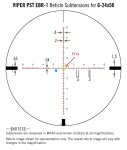thanks for the replies guys. i guess i am just over thinking it.
i guess part of the confusion lies with being accustomed to talking about inches for group size and being off "1.25 low and .5 right" because that's how grandpap taught us on a paper pie plate, in the middle of the woods, using a dead, moss covered limb as our rest while standing on the side of a hill. then we make the assumption that is how it is done, and in reality, there is a whole different way of thinking, looking, doing.
(an example of someone thinking to them selves at the range):
"so, if i am 1.25" low, i am at 200yds, i need to move my reticle, how many clicks? let's see, one click at 100 is .25", so at 200 it is.....?"
so from what i gather, fuck that, use the ruler that rob01 and a few others pointed out, and adjust for the read out.
is it really that simple? lol


